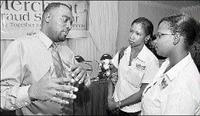
Richard Patterson, risk management/securities officer for the NCB Credit and Risk-Management Division, makes a point to unidentified employees of Watt's New, who were participants at an NCB merchant fraud seminar in Kingston. - File
The high-shopping Christmas season tends to see an increase in credit-card fraud and duplication. Here are some tips for individuals and merchants to guard against falling victim to scams and phishers:
1 Consumers must treat their card as if they were handling cash to avoid lost/stolen-card fraud or the fraudulent use of their card number. A simple strategy: If you wouldn't leave your cash there, do not leave your card.
2 Keep your card in full view at all times. Due care should be taken to observe the manner in which your card is handled by merchants. Where merchants have a mobile point-of-sale terminal, ask that this is taken to you or take your card to the terminal location, even in restaurants and gas stations.
Your card should only be swiped on the point-of-sale device or the merchant cash register.
3 Do not record your PIN on your card; commit the PIN to memory. Keep your sales receipts and compare these against your statements as soon as received. Call your financial institution to report any discrepancy and follow up in writing.
4 Merchants are required to ensure that customers' card information is kept securely, limi-ting access to only key personnel on a need-to-know-only basis.
5 Review the card-security features as per the guidelines provided by the financial institution. Where features are not consistent with these guidelines, the financial institution must be contacted for verification and further instructions. Do not rely on identification as a sole means of validation. Bogus drivers' licences, etc, local and overseas, are commonplace.
6 Keep an eye out for unusual purchase patterns. Do not be lulled into a false sense of security by repeat customers. It is common for fraudsters to trick merchants by making small-value cash purchases before returning with a counterfeit or lost or stolen card.
7 When in doubt, call the bank for verification.
8 Develop strong internal controls, such as setting transaction limits above which a manager must verify the card features and approve sale.
9 With Christmas approaching, fraudsters will be on the prowl to dupe unsuspecting individuals, merchants or their sales agents who may be more excited about the chance of a large commission. Extra vigilance is required.
10 Cards that are unembossed - that is, the card number is flat or printed - and/or have the words 'Electronic Only Use' written on them, must be treated with extra precaution. It is an increasing trend for fraudsters, who are no longer going through the trouble to emboss their bogus cards, to simply print the card number along with a bank's name, the cardholder's name as well as the expiry date on the front of a piece of plastic.
11 Customers using ABMs should check surroundings for anything unusual. One of the things fraudsters do to try to copy your PIN is to place devices like mini-cameras for observation purposes.
12 Monitor your bills. Card-holders need to be vigilant. Check items on credit-card bills against your receipts to ensure your card is not being used illegally.
- Information provided by NCB Risk Management and Securities Division and Elena Villafana-Sylvester, vice-president of electronic financial solutions & retail banking, Scotiabank Jamaica.